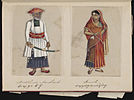Caste System in India
Pages from Seventy-two Specimens of Castes in India according to Christian Missionaries in February 1837. They include Hindu, Muslim, Sikh and Arabs as castes of India.
|
|||||
The caste system in India is the paradigmatic ethnographic example of caste. It has origins in ancient India, and was transformed by various ruling elites in medieval, early-modern, and, modern India, especially the Mughal Empire and the British Raj. It is today the basis of educational and job reservations in India. It consists of two different concepts, varna and jāti, which may be regarded as different levels of analysis of this system.
Varna may be translated as "class," and refers to the four social classes which existed in the Vedic society, namely Brahmins, Kshatriyas, Vaishyas and Shudras. Certain groups, now known as Dalits, were historically excluded from the varna system altogether, and are still ostracised as untouchables.
Jāti may be translated as caste, and refers to birth. The names of jātis are usually derived from occupations, and considered to be hereditary and endogamous, but this may not always have been the case. The jātis developed in post-Vedic times, possibly from crystallisation of guilds during its feudal era. Each of the thousands of jātis are often thought of as belonging to one of the four varnas.
The varnas and jatis have pre-modern origins, and social stratification may already have existed in pre-Vedic times. Between c. 2200 BC and AD 100, admixture between northern and southern populations in India took place, after which a shift to endogamy took place. This shift may be explained by the "imposition of some social values and norms" which were "enforced through the powerful state machinery of a developing political economy".
The caste system as it exists today is thought to be the result of developments during the collapse of the Mughal era and the British colonial regime in India. The collapse of the Mughal era saw the rise of powerful men who associated themselves with kings, priests and ascetics, affirming the regal and martial form of the caste ideal, and it also reshaped many apparently casteless social groups into differentiated caste communities. The British Raj furthered this development, making rigid caste organisation a central mechanism of administration. Between 1860 and 1920, the British segregated Indians by caste, granting administrative jobs and senior appointments only to the upper castes. Social unrest during the 1920s led to a change in this policy. From then on, the colonial administration began a policy of positive discrimination by reserving a certain percentage of government jobs for the lower castes.
...
Wikipedia




